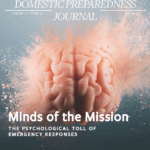In 1960, Admiral Chester W. Nimitz claimed that the United States predicted everything the Japanese would do in World War II—except for kamikaze strikes—through wargaming. With a long history in war scenarios, the discipline of wargaming can be applied to simulate and analyze different types of problem sets beyond warfare, such as crisis response.
Disaster wargaming (“gaming”) is a practice that could change how to approach tabletop exercises in emergency management and homeland security. While gaming and emergency management are not words commonly associated in the homeland security and emergency management communities, under the Homeland Security Exercise and Evaluation Program (HSEEP), “gaming” is an officially approved type of exercise by the U.S. Department of Homeland Security (DHS) and the Federal Emergency Management Agency (FEMA).

FEMA provides little elaboration on gaming other than what is mentioned in the HSEEP manual, which describes generic gaming (see Figure 1). Without past military experience, emergency managers may not understand the value of wargaming. Thus, much of the homeland security and emergency management community has not adapted and implemented gaming into training. However, advances in technology and gamification have created the perfect environment to utilize gaming in homeland security and emergency management training.
In fact, at the 2024 International Association of Emergency Managers (IAEM) Conference, three games and one artificial intelligence (AI) exercise designer made their public debut:
- The Centers for Disease Control and Prevention (CDC) premiered its new board game This is a Test, which focuses on radiological emergencies.
- The Center for Advanced Preparedness and Threat Response Simulation premiered a demonstration of a power outage game during a winter storm.
- EM Disaster Gaming showcased Emergency Operations Center: Wildfire Mayhem, a board game based on the historic Waldo Canyon Fire that simulates the Incident Command System–Emergency Operations Center interface to challenge players to work across tactical, operational, and strategic levels of a major disaster incident and manage the crisis and consequences of a disaster.
- On the other end of the disaster simulation spectrum, Justin Snair shared his public debut of , an AI-driven exercise.
Other games, including a free cybersecurity game from the Cybersecurity and Infrastructure Security Agency (CISA) and a pandemic exercise point of distribution game from the CDC, have also made their way to market. Gaming continues to expand and increase in availability and practice in new, effective ways.
Although they represent the forefront of gaming capability, video games and virtual reality are only two of the mediums available to use for disaster and emergency management training, education, and exercises. Other types include console video games, computer games, basic and advanced computer simulations (or disaster sandboxes), mobile gaming, flash games, and portable handheld games. Electronic or virtual mediums are also available but can be cost-prohibitive. Because computer and video games can be costly and take years to develop, traditional tabletop board games thrive and fill a critical gap in the gaming continuum as a practical and affordable option (see Figure 2).

Truth & Self-Deception – Training & Exercises in Emergency Management
Emergency managers lean heavily on tabletop exercises (TTXs) as a cost-effective solution that is ideal for small offices as they have a manageable investment of time and resources, so their accuracy and effectiveness are essential. One commonality among traditional exercises across all levels of government, and especially TTXs is poor integration of artificiality, often due to a mix of politics, competing interests, budgets, and personalities. While TTXs are effective tools, the artificialities in exercise practice oversimplify real challenges faced and lead to overly positive outcomes. This in turn negatively impacts emergency management programs and reduces the benefits of these exercises by hiding real challenges and failing to explore issues in meaningful ways.
Furthermore, this results in TTXs that can range significantly in quality. This is rooted in the way in which exercises, artificialities, and assumptions are developed, evaluated, and measured which is fraught with error, lacks rigor, and is often faulty. Poor exercise development hurts practice and leads to overly positive after-action reporting and lessons learned from the lack of rigor. If exercises are conducted to always provide successful outcomes with little actual challenge or difficulty, then after-action reports likewise are always positive, and there is little incentive for federal agencies to issue preparedness funds. Therein lies the greatest, self-inflicted wound of emergency management training and exercise practice. At the end of the day, failures should be acknowledged as learning points for improvement, not painted as rosy pictures that are far from the truth. Adapting professional military wargaming for homeland security and emergency management is one possible solution.
Disaster Wargaming—What Is a War Game?
A wargame is a dynamic representation of conflict or competition in a synthetic environment, in which people make decisions and respond to the consequences of those decisions. —Peter Perla, The Art of Wargaming: A Guide for Professionals and Hobbyists (1990)
Wargaming has been used famously by military, intelligence communities, heads of agencies, and even the White House as a way to prepare for and understand impacts and consequences of war, backed by centuries of rigorous decision science, since before the 19th century. For example, the German submarine wolfpack tactics that prevented some 90 percent of Allies’ shipping were developed using wargaming. On the other side, the Allies used wargaming at the U.S. Naval Academy to develop counter tactics to stop German U-Boats.
Historically from the ancient past through the present day, war games have been used to understand decision-making and the consequences of those decisions. War games even predate the game of chess, and modern war games used by the military have been famously adapted for civil recreational use as the popular game Dungeons & Dragons and other war games simulating famous military campaigns from the Napoleonic Wars to World War II and present-day conflicts (see Figure 3).

A more famous example is the three-day 1961 Berlin Political-Military War Game at Camp David. That game was so influential that Carl Kaysen, the deputy special assistant for national security affairs, wrote about it to President John F. Kennedy in a memorandum that would become the basis for policy for how the United States would respond to the Cuban Missile Crisis (see Figure 4).

There are numerous examples, past to present, on the famous use of wargaming. In the present day, the practice has been used for the global pandemic response and to prepare for foreign conflicts. In the decade prior to COVID-19 and a couple years before the H1N1 swine flu pandemics, war-game exercises were held based on a novel, highly pathogenic influenza virus that emerged overseas to address state, national, and international strategic issues.
Between February 2006 and June 2008, the Strategic Policy Forum (SPF), the strategic exercise group within NDU targeting senior executive and legislative participants, conducted six pandemic influenza exercises, addressing state, national, and international strategic issues. Two [war game] exercises were conducted in Washington, DC, in February 2006 and again in February 2007 for sets of participants that included Members of Congress and senior executive branch participants from a wide range of agencies. At the invitation of the respective governors, three state exercises were subsequently conducted in Alaska (August 2007) and Hawaii (December 2006 and January 2008) with many of the same executive branch participants, combined with state level elected officials and agencies. The cycle of games concluded with an international exercise conducted for American and Mexican officials and executive branch officials in May of 2008. Participants constituted an unusually broad and representative sample of policymakers involved in the planning for and response to pandemic. (Joint Force Quarterly, 2010)
Putting Disaster Wargaming into Practice
The best disaster-related war games cannot be cheated or overly gamed. They are realistic and replicate real-life emergency management by simplifying core systems, such as the National Response Framework, National Incident Management System, and Incident Command System, into a framework that allows individuals or teams to test, exercise, and evaluate all manner of plans, policies, strategies, tactics, and assumptions. Failure at these war games only serves to make a better real-life emergency manager. In disaster wargaming, the complex interdependent systems that comprise emergency and disaster management are distilled, simplified, and modernized. Just as in real life, a player must play through the challenge of managing resources, disaster logistics, political turmoil, and uncertainty. In effective disaster wargaming, no operation is a guaranteed success. This feature is a probability mechanism called the “chaos system,” and it is embedded into different elements of an effective game, causing random failures. (Note: The chaos system used in the novel game Disaster Wargaming was created by and is credited to the author, Arthur J. Simental.)
A disaster scenario may include a complex incident with multiple cascading impacts and crises. The chaos system captures natural challenges faced. As a result, players may need to acquire more resources, repair a flat tire, or treat an injured character in the game. The more natural representations that are in the game medium, the less resistant participants are to the exercise scenario. This in turn provides greater immersion and engagement not observed in traditional exercises. Gaming also requires and tests players’ soft skills such as critical thinking, diplomacy, tact, and listening and communication skills. In light of the benefits of wargaming throughout history and in the modern day, adapting and implementing disaster wargaming more widely across homeland security and emergency management would be beneficial to real disaster outcomes.
Disaster wargaming presents a cutting-edge practice to revolutionize tabletop exercises. Gaming has yet to be fully explored and adapted for emergency management, mainly due to the resource-intensive nature of the technology. Disaster wargaming, however, could provide a cost-effective alternative to traditional training that creates rigorous exercises in a box, requiring minimal resources and time of emergency managers. Disaster wargaming is especially effective given the ability to take existing plans, policies, and procedures and turn them into effective exercise evaluation and measurement tools for rigorous analysis. Wargaming provides a new way to generate rich lessons learned and examine complex decision-making, impacts, and consequences. As many have said, “failure is one of life’s greatest teachers.” The ability to fail a disaster war game and then evaluate and learn from those decisions and the consequences leading to the simulation’s failure becomes one of the most unique and impactful elements of disaster wargaming compared to other types of exercises.

Arthur J. Simental
Arthur J. Simental, M.S., CEM, is a homeland security and emergency management professor, researcher, consultant, and career certified emergency manager. Mr. Simental is the founder and chief executive officer of Simental Industries Ltd. and EM Disaster Gaming, a homeland security and emergency management consulting firm, disaster gaming initiative, and disaster research collaborative. Mr. Simental is also a former public health advisor for the Centers for Disease Control and Prevention. Mr. Simental has over sixteen years of service in government, homeland security and emergency management, and emergency services. He has served all levels of government and private and nonprofit sectors in homeland security, emergency management, healthcare and public health, emergency preparedness, space and defense, security, education, and critical infrastructure. Mr. Simental is also a homeland security researcher; published author; threat liaison officer; a member of FEMA’s Science, Technology and Integration Special Interest Group; and disaster wargame creator.
- Arthur J. Simentalhttps://domprep.com/author/arthur-j-simental






